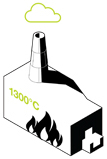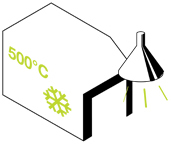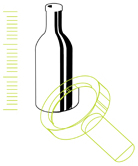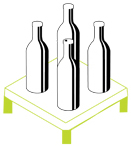
Glass Composition
At this stage, all raw materials are stored, measured and mixed to create the mass composition to be vetrified, which will be brought to furnaces where fusion will take place. The basic composition of glass package is:
Silicon Dioxide (SiO
2) 70 > 72%
Sodium Oxide (Na
20) 12 > 14%
Calcium Oxide (CaO) 9 > 11%
Magnesium Oxide (MgO) 0 > 3%
Aluminium Oxide (Al
20
3) 1 > 2%
Potassium Oxide (K
20) 0 > 1%
This composition incorporates treated used glass, ground glass wastes from internal and/or external recycling.

Raw Materials Fusion
At the refractory furnaces, the material fusion is processed at a 1,500 to 1,600º C temperature.
The liquefied glass moves along the large container under gravity action of the dropping material and goes through a "tuning" stage, where thermal homogeneity of the whole melted mass has to be guaranteed, as it is a crucial condition to obtain a product of quality.

Glass Forming
There are two stages in the moulding process of a piece:
in the first one, glass is introduced in the start mould located at one of the sides of the machine, where it takes its first shape (pre-form); in the second stage, the pre-form is transferred into the final mould located at the opposite side of the machine, where the final shape is given to the piece.

Annealing and Surface Treatment
During the moulding process, the glass is in contact with the mould walls, which are at relatively low temperatures.
As such, the external layers of the pieces are much colder than the internal ones, and this temperature differentials tends to be kept due to the poor conductivity of glass, therefore a thermal treatment, called annealing, is performed. This treatment consists of a thermal homogenisation of the whole glass mass, eliminating thus all tensions.

Inspection and Quality Control
After concluding the annealing procedure, the pieces are taken into automatic inspection machines that through several defect detection mechanisms dispose of faulty pieces.

Packaging
At the production line end, glass packages are grouped together by layers in pallets.
These are covered with plastic film to protect each unit and make transport easier; these packages are then shrinked in an adequate furnace, and afterwards pallets are conveyed to the storage area.
STAGE 1 - GLASS COMPOSITION
STAGE 2 - RAW MATERIALS FUSION
STAGE 3 - GLASS FORMING
STAGE 4 - ANNEALING AND SURFACE TREATMENT
STAGE 5 - INSPECTION AND QUALITY CONTROL
STAGE 6 - PACKAGING






